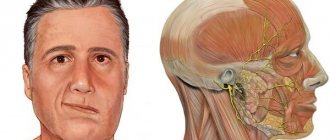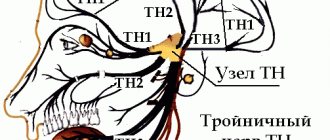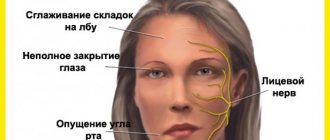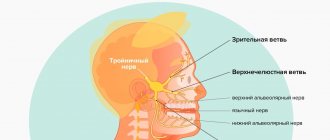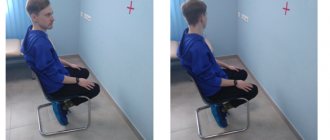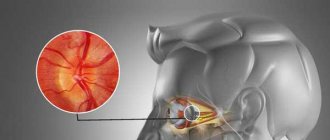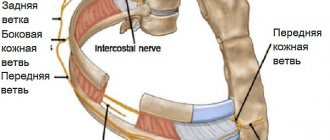Symptoms
The inflammatory process begins to develop gradually. At first there may be a feeling of pain behind the ear, but after a few days facial asymmetry occurs. The patient has a drooping corner of the mouth on one side, and the eye on the affected side squints poorly. When you try to close your lips into a “tube” on the affected side, your mouth becomes distorted. When you try to “blow out the candle,” the cheek on the affected side “sails.” There may be lacrimation from the eye on the affected side. With this pathology, a person loses the sense of taste on the front of the tongue. Hearing disturbance and increased salivation may occur. When closing an eye on the affected part of the face, the eye may not close completely. The patient's smile is asymmetrical. Symptoms develop over one or two days.
Important points of gymnastics for neuritis of the facial nerve
To make sure that the manipulations are performed correctly, it is better to conduct several trial sessions with your doctor. At home, gymnastics for neuritis of the facial nerve should be performed exclusively in front of a mirror and in a sitting position. This is necessary to control accompanying movements, the consolidation of which is extremely undesirable.
Before each exercise, it is important to achieve complete relaxation of the muscles, especially on the healthy side of the face.
Symmetry is another important condition when performing facial gymnastics. To achieve symmetry, it will be necessary to limit the range of movements of the healthy half of the face by holding it with your hand.
Gymnastics for facial neuritis: description of exercises FitFace
Gymnastics for neuritis of the facial nerve consists of the following exercises:
1. Tilt the head back and forth. Slow execution. Quantity: 6-8 times.
2. Alternately tilting the head to the shoulder located on the healthy side and passive bending (with the help of another person).
3. Turn the head left and right. Slow execution. Quantity: 6-8 times.
4. Fold your closed lips into a “tube”, then stretch them into a smile. Quantity: 6-8 times.
5. Inflate both cheeks at the same time and release the air noisily. Quantity: 6-8 times.
6. Simultaneous retraction of both cheeks. Quantity: 6-8 times.
7. Having taken air into your mouth, begin to move it from one cheek to the other.
8. Open and close your eyes tightly. Quantity: until tired.
9. Overcoming the effort of your healthy hand, which is holding your forehead, raise your eyebrows. Quantity: 6-8 times.
Therapeutic measures are aimed at enhancing the circulation of blood and lymph in the facial area, improving nerve conduction, restoring the functionality of facial muscles, and preventing muscle contracture.
In case of inflammatory damage to the facial nerve, the following is required:
- "Position treatment":
- sleep on the affected side;
- sit on a chair (3-4 times a day), bowing your head to the affected side, holding your head with your hand and leaning on your elbow (10 minutes).
- Massage of the collar area from the second week of the disease (using a gentle technique), starting from the healthy side.
- Myostimulation with microcurrents and facial massage.
- Gymnastics (FitFace application in the AppStore).
- Self-massage of the face (FitFace application in the AppStore, a complex called “Self-massage”).
Gymnastics for facial neuritis is a very important part of effective treatment. It is important that the patient strictly follows the specialist’s recommendations. And the doctor must evaluate a number of important aspects before carrying out any manipulations in the facial area.
Tests and diagnostics
A neurologist makes a diagnosis based on the patient’s complaints and clinical picture. The neurologist may ask you to make movements with your facial muscles - close your eyes, bare your teeth, raise your eyebrows, puff out your cheeks or whistle, and wrinkle your nose. Such tests allow the doctor to determine the presence of neuritis. If the diagnosis is in doubt, the doctor may prescribe the following tests:
- CT, MRI;
- Electroneuromyography (ENMG);
Additionally, the neurologist may recommend consultation with a neurosurgeon and otolaryngologist.
Treatment of neuritis of the facial nerve
Treatment begins with drug therapy to relieve swelling and inflammation. Treatment may include the following groups of drugs:
- glucocorticosteroids;
- vasodilators;
- diuretics;
- B vitamins (in the absence of allergic reactions);
- non-narcotic analgesics;
- Moisturizing drops may be prescribed for the eyes to prevent dry mucous membranes.
With secondary neuritis, it is necessary to treat the disease that caused the neuritis.
Facial neuritis (Bell's palsy)
Various types of trauma, hypertension, and atherosclerosis of cerebral vessels also affect this. Rarely, damage to the facial nerve occurs as a result of complications after diseases such as otitis media, mumps, inflammatory and other processes at the base of the brain. The same can happen from the dentistry side - with anesthesia and removal of the nerve.
More often, the manifestation of Bell's palsy can be observed by family members (incomprehensible conversation, facial distortion). Quite often, patients note these observations in the morning. The so-called general signs are manifested in numbness of a part of the face, drooping corners of the mouth, severe sensitivity to increased intonation, sharp sounds, dry mouth, ear pain, and changes in taste sensations.
Causes of Bell's palsy
Unfortunately, this is currently an uncertain factor. But one of the most common theories is based on the disease of viral infections. In a certain environment, activation of a virus such as HSV-1 can occur, which is located in nerve cells. With its active reproduction and production of toxins, inflammation of the nerve and disruption of nerve impulses are observed.
This conclusion must be obtained from a neurologist. The doctor needs to find out how quickly the symptomatic side of the disease appeared, whether there are any other symptoms, for example, headache, dizziness, whether the patient hears well or not, poor sensitivity of the extremities (legs and arms), wheezing. A full examination of the patient should also be carried out, to find out whether he had any illness before and what medications he took.
Also, one of the common causes of the disease can be the common herpes virus. There is a theory about the genetic transmission of Bell's palsy. Unfortunately, one of the reasons for long-term treatment is the fact that not all patients see a doctor on time, which in turn leads to a long recovery. Since not everyone knows how this disease progresses and its symptoms, many patients in the initial stages simply do not pay attention to it, hoping that it will go away on its own. Therefore, some cases are quite difficult to treat, or muscle reflexes are not fully restored, as they were before the disease.
Often, restoration of function is observed within the first month. The sooner it starts, the better the result will be. If the development of the disease lasted for three to six months, most likely the cause must be sought in another disease, in another ailment.
How to treat and diagnose Bell's palsy
The diagnosis is made by a doctor after a full examination and collection of tests. Perhaps the purpose of magnetic resonance imaging and electromyography is to see how the conductivity of nerve fibers is restored. If there is no improvement, other treatments are possible. The most commonly used treatment is corticosteroids. If you use steroids, for example, metipred, you can reduce the inflammation of nerve fibers and restore their previous conductivity. Analgesics and B vitamins are prescribed.
It is also possible to prescribe antiviral drugs Zovirax and acyclovir for treatment, and a course of acupressure is prescribed. When there is difficulty closing the eyes, everything possible must be done to keep the eyeball from drying out. Because blinking protects the eyes from environmental influences, and tears help preserve and maintain moisture levels. With the onset of paralysis, this function is often disrupted. It is a well-known fact that by blinking we prevent various types of infections from entering our eyes.
During this disease, the eyelid may close, but not completely, and dryness may be due to a small number of tears. Both types of indications are unsafe for the eyes. But you need to take care of your eyes, it’s elementary - drip your eyes with saline solution every two hours, you can put on glasses, a moisturizing bandage, in any case you experience discomfort in the eye, you need to immediately go to the doctor. The possibility of treatment using acupuncture and, in rare cases, surgical methods is also used.
Yes, this is all treatment from traditional medicine, but, like any other disease, there is also treatment with folk remedies. Everyone knows the fact that almost a century ago people were more often treated with them, although nothing stands still. So, how can you cure neuritis of the facial nerve using folk remedies?
Special facial gymnastics, which can be done at home, standing in front of a mirror 1-2 times a day, are very helpful in treating the disease. There are various cocktails that can be prepared at home; the course of treatment may take several months.
One of the important components for the prevention and treatment of relapses of this disease plays a role in the function of restoring the balance of the nervous system, increasing the level of resistance in stressful situations through various therapeutic and preventive activities, and immunomodulating therapy is carried out to increase the level of immunity.
If the cause is a disease such as ischemia, drugs are prescribed that improve blood flow and nutrition of nerve endings in order to eliminate problems in the blood vessels.
With a comprehensive and individual approach to the treatment of neuritis, greater effectiveness can be observed, which makes it possible to restore motor-muscular activity on the face, sensitivity, taste and hearing disorders, facial distortion, and restore the activity of lacrimation and salivation and their glands. Author: K.M.N., Academician of the Russian Academy of Medical Sciences M.A. Bobyr
Consequences and complications
Treatment must be started as quickly as possible, because
a year after the onset of the disease, the muscles will completely atrophy and their functionality cannot be restored. Complications may occur if therapy is not started at the first signs of the disease. With a long course of the disease, contracture of the facial muscles may occur, which is very difficult to restore. Disturbances in the sense of taste, visual disturbances (blindness, corneal ulcer), spasm of the muscles of the face and eyelid may occur. Consequences after the disease in some cases can last a lifetime.
Signs of development of neuritis of the facial nerve
Often, neuritis of the facial nerve is observed precisely in the heat, when people, trying to escape from high temperatures, use air conditioners. Therefore, it is important to choose the location of this technique wisely to avoid problems with the facial nerve.
Air conditioning is often the culprit for facial neuritis.
After a month or a month and a half, it may seem that the healthy side is paralyzed (due to contracture of the facial muscles). Patients describe the sensations during contracture as an unpleasant tightening. Contracture is especially pronounced during stress (physical and mental), in the cold, and during excitement.
Below we will introduce you to:
- rules and important points of performing gymnastics for facial nerve neuritis (FN);
- directly with gymnastics exercises for NLN.
The main signs indicating neuritis of the facial nerve are:
- inability to close the eye on the affected side, turning the eyeball upward;
- unilateral smoothness of nasolabial folds;
- swelling of the cheek during a conversation;
- accumulation of hard food between the cheek and gum while eating;
- pouring drinks out of the corner of the mouth.

